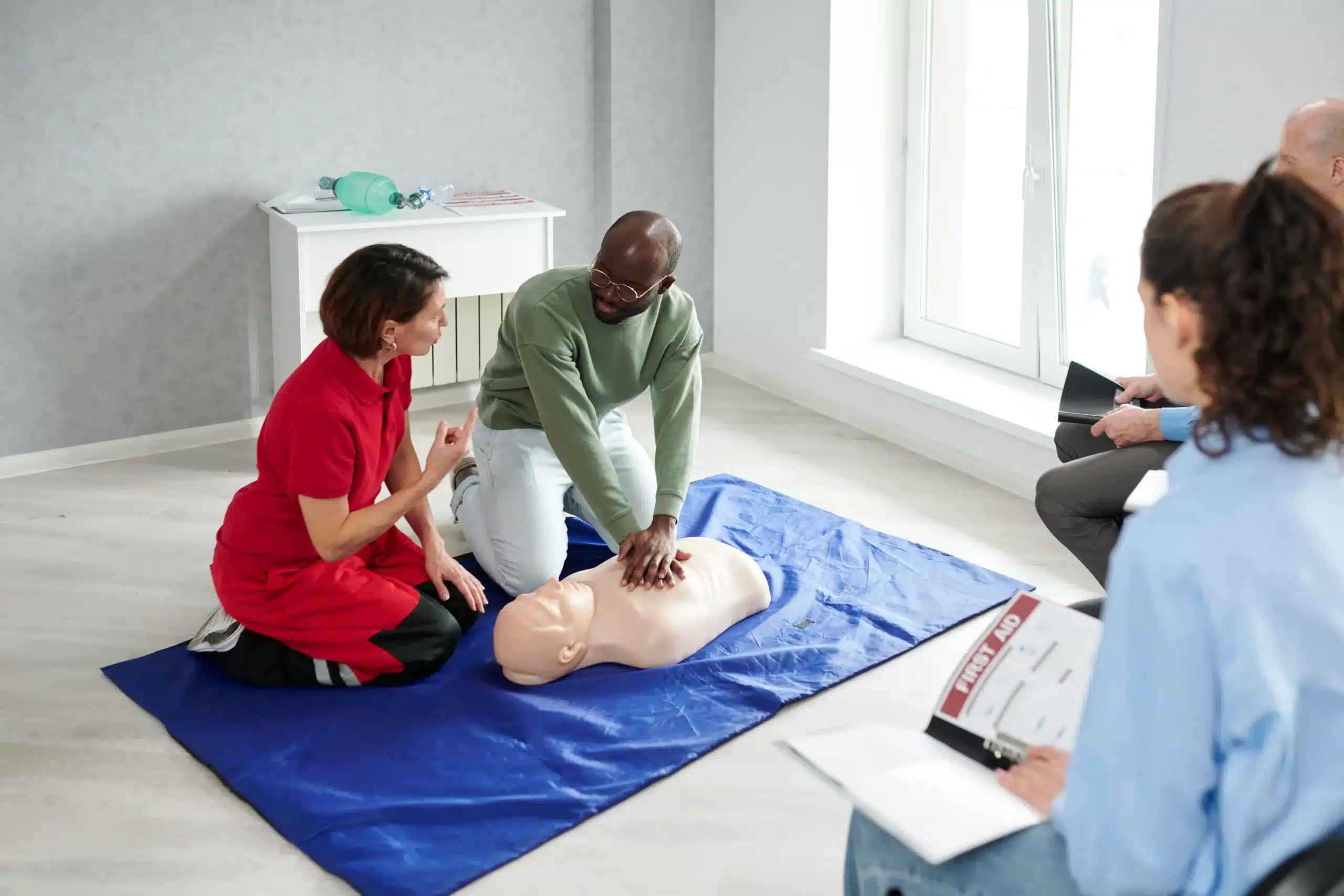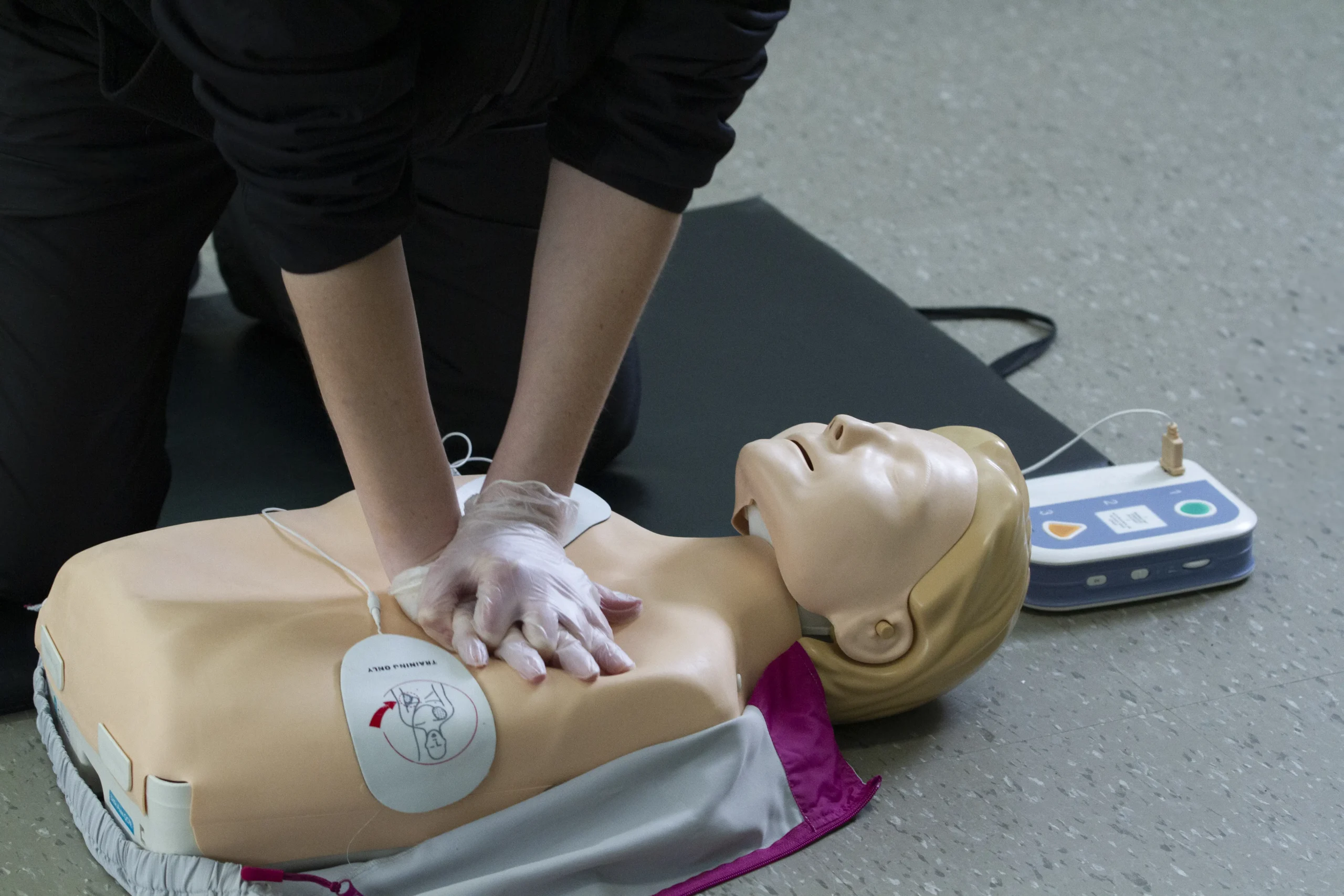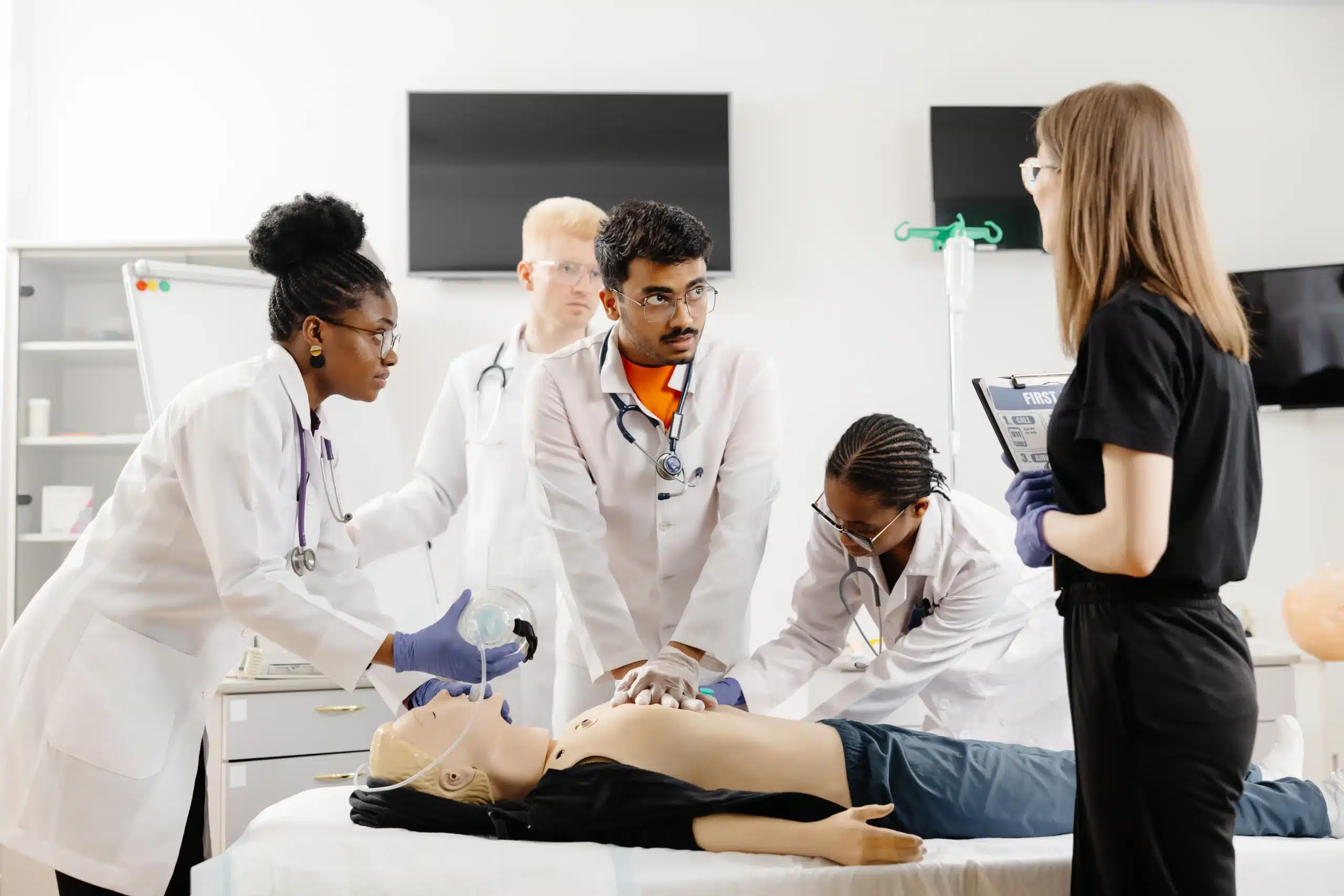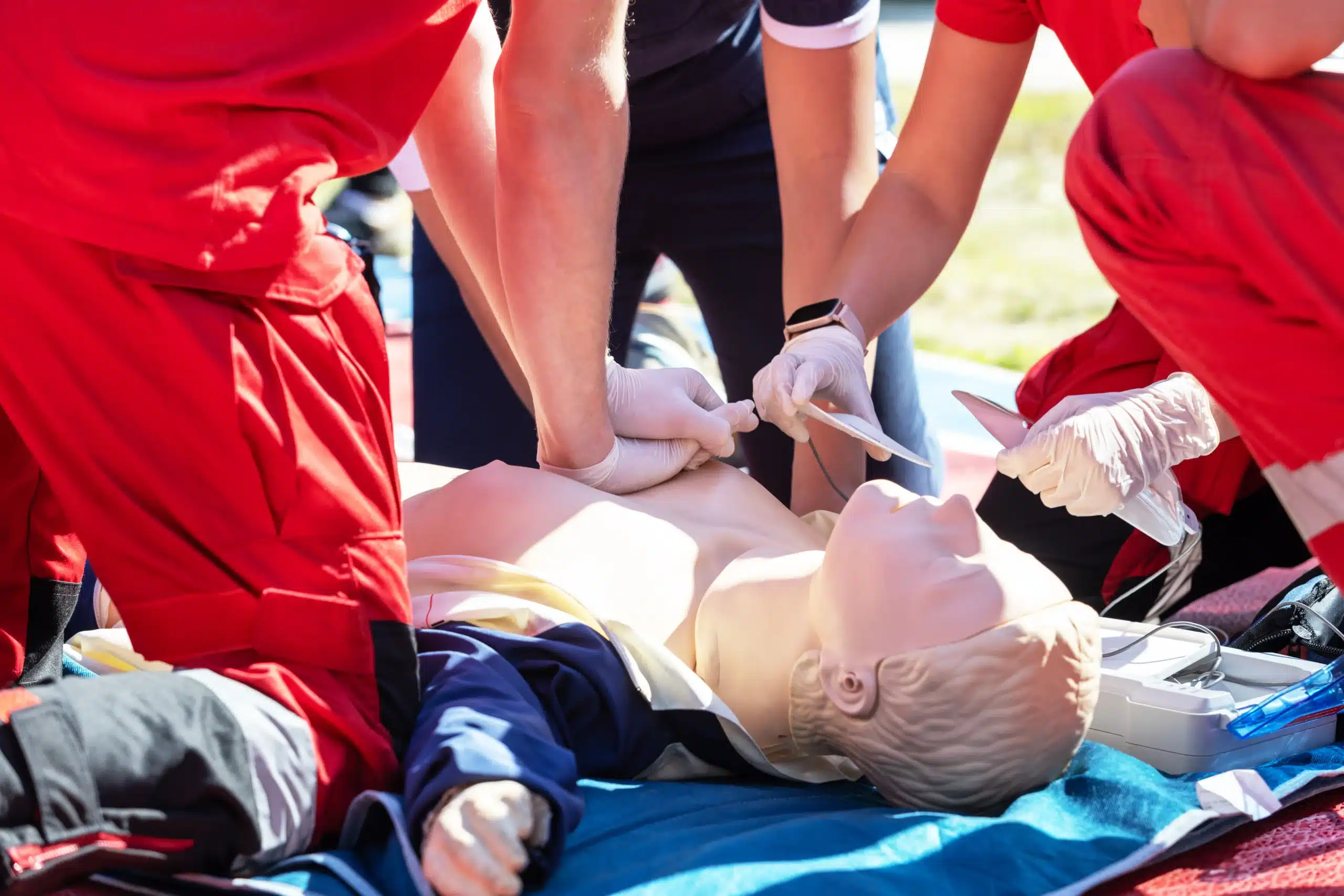Balancing work, family, and other commitments often leaves little room for essential training like CPR. But what if you could learn these life-saving skills from the comfort of your own home, at your own pace? Online CPR classes in Sacramento offer precisely that flexibility. This article serves as your go-to resource for everything related to online CPR training in Sacramento. We’ll cover the various types of CPR certifications available, discuss the pros and cons of different online learning formats, and provide practical tips for getting the most out of your online CPR course. We’ll also address common misconceptions about online CPR training and guide you toward choosing the right course to fit your busy lifestyle.
Key Takeaways
- Online CPR training offers flexible options: Combine online coursework with in-person skills sessions to fit your schedule and learning style. Explore self-paced learning, live virtual classes, or blended learning formats.
- Choose the right CPR certification: From basic CPR/AED to advanced certifications like BLS and ACLS, select the course that aligns with your career goals and specific requirements. Consider First Aid/CPR combination courses for a well-rounded skill set.
- Verify certification validity and acceptance: Ensure your chosen course meets employer and industry standards, including OSHA requirements if applicable. Select reputable providers like the AHA or Red Cross for widely accepted certifications.
What are Online CPR Classes in Sacramento?
Online CPR classes in Sacramento offer a convenient way to learn life-saving skills. These courses blend online learning with in-person practice. This means you can study the theory at your own pace and then demonstrate your skills in a hands-on session. This blended learning format makes CPR certification more accessible, especially for busy professionals and those with scheduling challenges. Organizations like the American Red Cross offer this combined approach, balancing the flexibility of online study with the importance of practical application. The American Heart Association (AHA) also recognizes the effectiveness of this method for both healthcare providers and the general public. Online learning streamlines the certification process, making it easier to fit CPR training into your schedule. The Red Cross, for instance, uses blended learning to ensure you’re prepared for real-world emergencies by requiring in-person skills demonstrations after you complete the online coursework.
Top Online CPR Class Providers in Sacramento
Finding the right CPR certification course can feel overwhelming with so many options. This section breaks down some of the top providers in Sacramento, highlighting what they offer so you can choose the best fit.
Safety Training Seminars
Safety Training Seminars stands out for its comprehensive approach to CPR and first-aid training. As a woman-owned, American Heart Association (AHA) Training Center, they offer a wide range of AHA courses, including CPR, BLS, ACLS, PALS, and First Aid. They provide official AHA certification cards, valid for two years, and prioritize affordability with a low-price guarantee. Their flexible scheduling, with classes offered seven days a week, caters to busy professionals and individuals seeking convenient training. Learn more about their BLS certification, ACLS certification, EMSA Child Care Health & Safety training, and RQI classes. They are committed to providing high-quality training at the lowest prices in Sacramento County.
American Red Cross
The American Red Cross is a well-known provider of CPR training, offering various learning formats, including in-person, online, and blended learning. Their in-person CPR classes provide hands-on training and a two-year certification that meets OSHA requirements. For those seeking flexibility, their online and blended learning courses combine online instruction with in-person skills sessions. Explore their CPR and First Aid training options on their website.
CPR Certification Sacramento
CPR Certification Sacramento focuses on providing American Heart Association (AHA) certified CPR and First Aid classes. They emphasize speed and efficiency, offering same-day certification cards upon completion. With a track record of training over 100,000 students nationwide, they have established themselves as a prominent provider. Visit their website for more information on courses and schedules.
ProCPR
ProCPR offers a variety of online CPR courses designed for both individuals and organizations. Their flexible, self-paced format allows students to complete the coursework at their own convenience. This makes ProCPR a good option for those with busy schedules or who prefer independent learning. Find details about their online CPR courses on their website.
National CPR Foundation
The National CPR Foundation provides online CPR training with an emphasis on accessibility and affordability. They focus on delivering high-quality education to ensure learners are prepared for emergencies. Their online platform makes CPR training accessible to a wider audience, regardless of location or schedule. Learn more about their online CPR training programs on their website.
Available CPR Certifications and Course Types
Choosing the right CPR certification depends on your specific needs and career goals. Here’s a breakdown of common CPR certifications and course types offered in Sacramento:
Basic Life Support (BLS)
Basic Life Support (BLS) certification focuses on providing high-quality CPR for adults, children, and infants. It also covers using an automated external defibrillator (AED) and relieving choking. BLS certification is crucial for healthcare providers, including doctors, nurses, paramedics, and other medical professionals. Sacramento CPR Certification offers BLS certification courses aligned with the latest American Heart Association guidelines. These guidelines emphasize chest compressions, airway management, and effective team dynamics during resuscitation.
Advanced Cardiac Life Support (ACLS)
Advanced Cardiac Life Support (ACLS) builds upon the foundational skills learned in BLS. This advanced certification is designed for healthcare professionals who manage cardiopulmonary arrest and other cardiovascular emergencies. ACLS courses cover a broader range of topics, including effective team communication, recognizing and treating strokes, and managing acute coronary syndromes. If you’re a physician, nurse, or paramedic working in critical care, ACLS certification is essential.
Pediatric Advanced Life Support (PALS)
Pediatric Advanced Life Support (PALS) focuses on the specialized skills needed to respond to life-threatening emergencies in infants and children. This certification equips healthcare providers with the knowledge and skills to assess, manage, and stabilize pediatric patients. PALS courses emphasize effective team dynamics and rapid response to critical situations. While we don’t currently offer PALS certification at Safety Training Seminars, we recommend checking the American Heart Association website for course options.
First Aid and CPR Combination Courses
Combining First Aid and CPR training provides a well-rounded skill set for responding to various emergencies. These courses teach how to manage injuries, control bleeding, and provide basic life support until professional medical help arrives. First Aid and CPR combination courses are valuable for anyone, from healthcare professionals and childcare providers to teachers and parents. They empower individuals to confidently handle both minor and life-threatening situations.
Online CPR Course Format and Duration
Finding the right CPR class often comes down to format and how much time you have. Let’s break down the common online CPR course structures and what to expect.
Self-Paced Learning
Online, self-paced learning gives you the flexibility to complete the coursework on your own time. This is perfect if you have a busy schedule or prefer to learn at your own speed. You can review materials as often as needed and fit the training around your other commitments. Many providers, including the American Red Cross, offer this type of online CPR training. This format often works well for people who learn best independently and can manage their own study schedule effectively.
Live Virtual Classes
If you thrive in a more interactive environment, live virtual classes might be a better fit. These classes offer real-time instruction and allow you to ask questions and engage with the instructor and other participants, much like a traditional classroom setting. CPR Sacramento is one provider to check with for live virtual class schedules. This format can be particularly helpful for those who prefer direct interaction and immediate feedback.
Blended Learning Options
Blended learning combines the best of both worlds. You’ll complete the online coursework at your own pace and then attend an in-person skills session. This hands-on component allows you to practice techniques and receive feedback from a certified instructor. The American Heart Association often uses this blended learning approach for their BLS certification. This option provides the flexibility of online learning with the crucial benefit of in-person skills practice.
Hands-On Skills Evaluation
Regardless of whether you choose self-paced, live virtual, or blended learning, a hands-on skills evaluation is essential for CPR certification. This evaluation typically involves demonstrating CPR techniques on a manikin under the supervision of a certified instructor. This ensures you’re not only knowledgeable about the procedures but also confident in performing them. Organizations like Student CPR provide more information on the importance of this practical component. The skills evaluation usually takes a few hours and is often scheduled separately from the online coursework. This in-person component ensures you can confidently apply your knowledge in a real-world scenario.
Cost of Online CPR Classes & Value
Understanding CPR class costs and what you get for your money is essential when choosing a course. Let’s break down pricing structures, potential discounts, and how to compare value across different providers.
Pricing Structures
CPR class prices in Sacramento vary based on the provider and the type of certification. For example, Safety Training Seminars offers the American Heart Association (AHA) BLS CPR & AED course for $59.95, while their BLS CPR, AED & First Aid combo course is $79.95. These certifications are valid for two years. You can find more details on their BLS course page. Keep in mind that these prices are competitive, especially given Safety Training Seminars’ low price guarantee. Always check the provider’s website for the most up-to-date pricing.
Group Discounts and Special Offers
If you’re training a team or group, ask about potential discounts. Many CPR training providers offer reduced rates for group bookings. This can be a cost-effective way to ensure everyone gets certified together. For larger groups, on-site training can often be arranged for added convenience.
Additional Costs
While the advertised course fee usually covers the core instruction and certification card, be aware of potential extra costs. Some providers might charge separately for study materials, practice equipment, or online access codes. Blended learning courses, like those offered by the American Red Cross, often involve an online component combined with an in-person skills session. Factor in any additional fees when comparing the total cost.
Compare Provider Value
Don’t just focus on the lowest price. Consider the overall value. Look at what’s included in the course, the provider’s reputation, the type of certification offered (AHA or Red Cross, for instance), and the convenience of the class schedule and location. Safety Training Seminars, for example, offers a wide range of AHA courses, including BLS, ACLS, PALS, and First Aid, giving you options to meet your specific needs. Weigh these factors to choose the best value for your investment.
CPR Certification Validity and Industry Recognition
It’s crucial to understand that not all CPR certifications hold the same weight. Your certification needs to be widely recognized and accepted by employers and regulatory bodies. Let’s break down what to look for:
Employer Acceptance
Many online-only CPR certifications exist, but their legitimacy is often questionable. Major certifying organizations like the American Heart Association and the American Red Cross require hands-on training and assessment to ensure you develop practical skills for real-life emergencies. Before signing up for any online CPR class, verify whether your employer will accept the certification. Check with your company’s HR department or relevant professional organization for their specific requirements. This due diligence can save you time and money in the long run.
Renewal Requirements
CPR certifications typically expire after two years. This ensures professionals stay up-to-date with the latest guidelines. Check the specific renewal requirements of your certifying organization. Staying current with your CPR skills is essential for providing effective care and maintaining your professional credentials. Plan ahead for your renewal to avoid any lapse in your certification.
Meeting OSHA Standards
For many healthcare professionals, meeting OSHA standards is a must. In-person CPR classes that include hands-on training typically lead to a two-year certification that meets these requirements. Online-only classes do not provide OSHA-compliant certification. If your profession requires it, make sure your chosen CPR course aligns with OSHA standards. Look for courses that emphasize practical skills and offer a recognized certification. This will ensure you’re fully prepared to meet workplace safety regulations.
Benefits and Drawbacks of Online CPR Training
Deciding between online and in-person CPR training? Both have their pros and cons. Understanding these will help you choose the best fit for your lifestyle and learning preferences. Let’s break down the advantages and disadvantages of online CPR training:
Flexibility and Convenience
Online CPR training offers incredible flexibility. You can learn at your own speed and revisit material whenever you need a refresher. This self-paced format is perfect if you have a busy schedule or prefer learning in shorter bursts. You can squeeze in a module during your lunch break or study late at night—whatever works for you. This is a major advantage over traditional in-person classes, which often require a fixed time commitment. For busy professionals, parents, or students, the flexibility of online learning can be a game-changer.
Interactive Learning
Effective CPR training needs to be engaging. Many online CPR courses use interactive elements like quizzes, videos, and simulations to make learning fun and effective. These tools can help you grasp the material better than simply reading from a textbook. For example, some platforms offer virtual simulations where you can practice your CPR technique in a realistic, risk-free environment. This type of interactive learning can be incredibly valuable for building confidence and preparing you for real-life scenarios.
Access to Resources
Online CPR courses often provide a wealth of resources beyond the core curriculum. You might find downloadable guides, printable checklists, or links to additional information from organizations like the American Heart Association, which recognizes the value of blended learning approaches. Having these resources readily available can reinforce your learning and provide ongoing support even after you complete the course.
Addressing Misconceptions
It’s important to be aware of some common misconceptions about online CPR training. While online courses offer a convenient way to learn the cognitive aspects of CPR, they can’t fully replace the hands-on practice required for proper certification. Organizations like the AHA require a hands-on skills evaluation component. Be sure to choose a program that includes this crucial step, like those offered by Safety Training Seminars, to ensure you receive a valid and recognized certification. Don’t fall for programs advertising “online-only” CPR certifications—they often aren’t legitimate and may not be accepted by employers or licensing boards. A blended learning approach, combining online study with in-person skills checks, is often the best path to a comprehensive and credible CPR certification.
Choose the Right Online CPR Class
Finding the right online CPR class involves understanding your needs, comparing available features, and setting yourself up for online learning success. Let’s break down each step.
Assess Your Needs
Before browsing online CPR courses, consider what you need from your training. Are you learning CPR for personal knowledge or to meet a job requirement? Think about your schedule and preferred learning style. Do you thrive in a self-paced environment or prefer live interaction? Understanding your needs helps narrow down the options and find the best fit. For example, healthcare professionals likely need an AHA-certified course like BLS or ACLS, while a childcare provider might need to fulfill specific requirements like those outlined in the EMSA Child Care Health & Safety guidelines. Consider also if you need RQI classes.
Compare Course Features
Once you understand your needs, compare course features. Look at what different providers offer. Do they provide online, in-person, or blended learning options? What about the format of the online portion—is it self-paced modules, live virtual classes, or a combination? Check if the course includes downloadable resources, practice tests, or instructor support. Safety Training Seminars offers a range of AHA courses, while the American Red Cross has its own certifications. Make sure the course aligns with your certification needs and learning preferences.
Tips for Online Learning Success
Online learning requires a different approach than traditional classrooms. To make the most of your online CPR training, create a dedicated learning space free from distractions. Actively engage with the course material. Take notes, participate in discussions (if available), and ask questions. Hands-on practice is crucial for CPR, so if your course includes a blended learning component, schedule and complete the in-person skills evaluation. Effective CPR training involves a mix of knowledge and practical skills. Resources like the National CPR Center offer insights into blended learning approaches, combining online modules with hands-on practice, as discussed in this article on blended learning in AHA CPR courses. Don’t forget to check our low price guarantee.
Enhance Your Online CPR Learning
Online CPR training offers incredible flexibility, but maximizing its effectiveness involves more than just clicking through modules. Think of your online coursework as the foundation upon which you’ll build essential, life-saving skills. Here’s how to enhance your online CPR learning experience:
Supplementary Resources
Many organizations, including the American Heart Association (AHA), offer supplementary resources to enrich your online CPR training. Look for downloadable guides, quick reference sheets, and videos demonstrating various CPR techniques. These resources reinforce key concepts and can be valuable refreshers even after you’ve completed your certification.
Practice Kits and Simulations
Online learning provides the knowledge, but practical application solidifies those skills. Hands-on practice is crucial for mastering CPR. Invest in a CPR practice kit, which typically includes a manikin and instructions. Practicing chest compressions, rescue breaths, and proper hand placement on the manikin builds muscle memory and confidence. Some online courses even incorporate simulations, allowing you to apply your knowledge in virtual scenarios.
Instructor Support and Q&A
Even with the convenience of online learning, access to a qualified instructor is invaluable. Instructors can answer your specific questions, clarify complex procedures, and provide personalized feedback. Don’t hesitate to reach out to your instructor for guidance—they are there to support your learning journey. Many online CPR courses offer live Q&A sessions or opportunities to connect with instructors via email or online forums.
Community Engagement
Learning CPR is a powerful step towards creating a safer community. Connect with others taking online CPR courses and share your learning experiences. Community engagement fosters a culture of preparedness and empowers individuals to respond effectively in emergencies. You might even consider organizing a practice session with friends or family members to strengthen your skills together.
Key Considerations for Online CPR Classes
Choosing the right online CPR class involves several key factors. Think about your personal learning style and available time. Do you prefer self-paced learning where you can review materials at your own speed? Or do you thrive in a more structured environment with live virtual classes? Consider your reason for training. Are you fulfilling a job requirement or simply seeking personal knowledge? This helps determine the right course level. Explore different learning options to find the best fit.
The American Heart Association (AHA) offers a blended learning approach for many of its CPR courses, combining online learning with essential hands-on practice. This format offers the convenience of online learning while ensuring you gain practical skills. Many providers offer various courses, from basic CPR/AED training to advanced certifications like BLS, ACLS, and PALS. Learn more about AHA certifications and how they can benefit you.
Finally, confirm whether your employer accepts online certification or requires in-person training. If you’re training with a group, ask about potential discounts. Considering these factors will help you find the perfect online CPR class to meet your specific needs. Check for group discounts and offers to save on training costs.
Related Articles
- CPR Classes in Sacramento: The Complete Guide – Sacramento CPR Classes
- BLS CPR Classes in Sacramento, CA – Sacramento CPR Classes
- CPR Training in Sacramento: Your Guide – Sacramento CPR Classes
- CPR Certification in Sacramento: Your Guide – Sacramento CPR Classes
- Online ACLS Classes in Sacramento: Your Guide – Sacramento CPR Classes
Frequently Asked Questions
Is online CPR certification enough, or is in-person training required?
While online CPR courses offer a convenient way to learn the material, most reputable certifying organizations, like the American Heart Association and the American Red Cross, require an in-person skills evaluation component. This involves demonstrating your CPR techniques on a manikin under the supervision of a certified instructor. This hands-on component is essential for receiving a valid and widely accepted certification.
How long does online CPR certification last, and how do I renew it?
CPR certifications are typically valid for two years. Renewal requirements vary depending on the certifying organization (AHA, Red Cross, etc.), so it’s best to check with them directly for specific instructions. Generally, renewal involves completing a refresher course, which may include both online and in-person components.
What’s the difference between BLS, ACLS, and PALS certifications?
BLS (Basic Life Support) focuses on fundamental CPR skills for adults, children, and infants, along with AED use and choking relief. ACLS (Advanced Cardiac Life Support) is more advanced and geared towards healthcare professionals managing cardiac arrest and other cardiovascular emergencies. PALS (Pediatric Advanced Life Support) specializes in the care of infants and children during life-threatening situations.
How much do online CPR classes cost, and are there any discounts available?
The cost of online CPR classes varies depending on the provider, the type of certification, and whether it includes in-person skills evaluation. Many providers offer discounts for group bookings or special promotions. It’s always a good idea to contact the provider directly for the most up-to-date pricing information.
What are the benefits of taking a blended learning CPR course?
Blended learning combines the flexibility of online coursework with the essential hands-on practice of in-person skills sessions. This format allows you to learn the material at your own pace and then demonstrate your skills under the guidance of a certified instructor. This combination often leads to a more comprehensive and confident understanding of CPR techniques.








